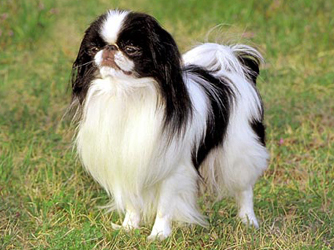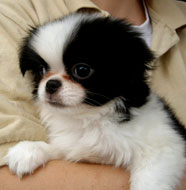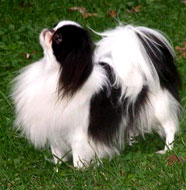| |
|
|
Japanese Chin Information

Japanese Chin Facts
| Size |
Small |
| Male Max Weight |
4-7 lb |
| Female Max Weight |
4-7 lb |
| Life Span |
10-12 years |
| Energy Level |
 |
| Ease of Training |
 |
| Grooming |
 |
| Shedding |

|
| Exercise Requirements |

|
| Playfulness |

|
| Affection Level |

|
| Good With Dogs |

|
| Good With Pets |

|
| Good With Strangers |

|
| Watchdog Ability |

|
| Protection Ability |

|
| Cold Tolerance |

|
| Heat Tolerance |

|
Japanese Chin Temperament
|
The Japanese Chin is a great companion that enjoys being on the
lap of its owner. As much as it enjoys this, it is also an active breed that enjoys an
energetic play session. The Japanese Chin has a tendency to want to be wherever its owner
is. This breed is friendly with people and animals that it does not know. It is mild
mannered and does well around children. The Japanese Chin has been compared to a cat in
the past due to its catlike personality
traits.
|
Japanese Chin Upkeep
|
The Japanese Chin is energetic and requires physical activity.
Because of its small size, these exercise requirements can be met with a walk or a play
session. The Japanese Chin does not do well in an outdoor environment or in weather that
is hot. This breed may have a tendency to wheeze, especially in humid conditions. The
coat of the Japanese Chin requires minimal maintenance with combing necessary two times
each week.
|
Japanese Chin Health
|
The minor health concerns for the Japanese Chin include patellar
luxation, KCS, entropion, cataracts, and a heart murmur. Occasionally seen in this breed
is achondroplasia, epilepsy, and portacaval shunt. Regular testing of the knees and eyes
is suggested. The average life span of a healthy Japanese Chin is ten to twelve years.
This breed can also develop corneal
abrasions.
|
Japanese Chin History
|
Unlike the name of the Japanese Chin, the breed actually
originated in China. The Japanese Chin has a similar history to the Pekingese as it was
often given as a gift to the nobility. There are different theories about how the
Japanese Chin first made its way to Japan. One thought is that it was brought to Japan by
Zen Buddhist teachers around A.D. 520. Another belief is that a Korean prince arrived in
Japan with several of these dogs in A.D. 732. A last theory is that the breed may have
been given as a gift to a Japanese emperor by a Chinese emperor more than a thousand
years ago. Despite its method of arrival, this breed was fancied by the Japanese Imperial
family. It was originally thought of as a lapdog or a decoration, with some of the dogs
being so small that they were kept in bird cages. The Japanese Chin eventually made its
way to Europe by way of Portuguese sailors that were trading with Japan during the
sixteenth century. In 1853 the first Japanese Chin officially arrived in Europe as
Commodore Perry offered a pair of these dogs from Japan to Queen Victoria. The Japanese
Chin continued to increase its presence in Europe and America as traders brought these
dogs over. The breed was initially recognized by the name Japanese Spaniel during the
late 1800s by the AKC. The Japanese Spaniel dogs were bigger in size then the Japanese
Chin of today and there is a theory that the smaller size came when the dogs were crossed
with the English Toy Spaniel. The trading and import of the Japanese Chin was reduced
after World War I but the breed remained popular. Today the breed has a modest presence
in America while it is still greatly favored in
Japan.
|
Japanese Chin Pictures
|
Puppies

Middle Aged

|
Japanese Chin Videos
|
|
|







